Microeconomics Assignment on Minimum Wage and Labour Market
VerifiedAdded on 2023/06/04
|11
|1790
|473
AI Summary
This assignment discusses the concept of minimum wage as a price floor and its impact on the labour market. It includes calculations of consumer surplus, producer surplus, total surplus, dead weight loss, and resource cost. The assignment also analyzes the impact of minimum wage on allocative efficiency, standard of living, and skilled and unskilled labourers.
Contribute Materials
Your contribution can guide someone’s learning journey. Share your
documents today.
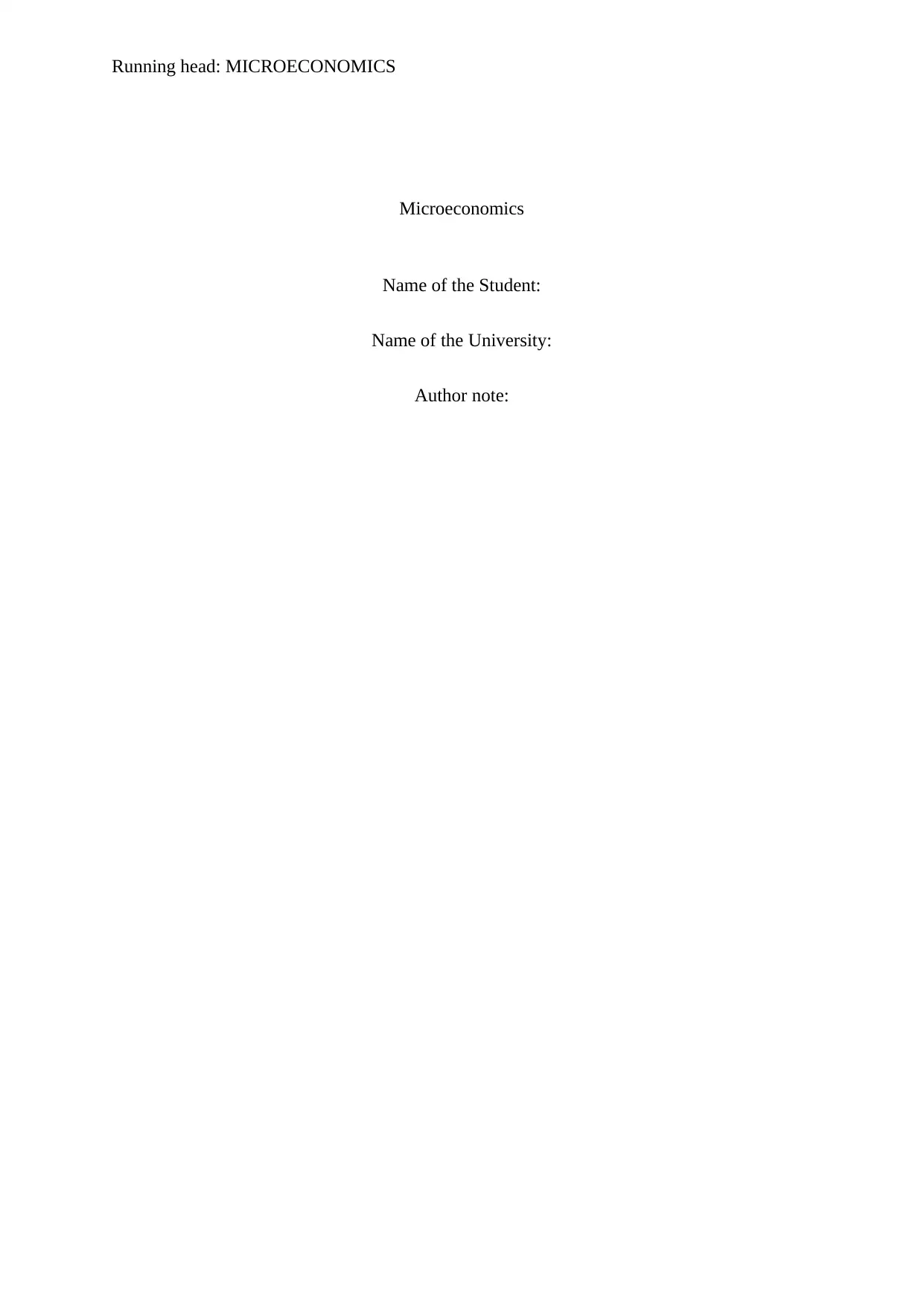
Running head: MICROECONOMICS
Microeconomics
Name of the Student:
Name of the University:
Author note:
Microeconomics
Name of the Student:
Name of the University:
Author note:
Secure Best Marks with AI Grader
Need help grading? Try our AI Grader for instant feedback on your assignments.
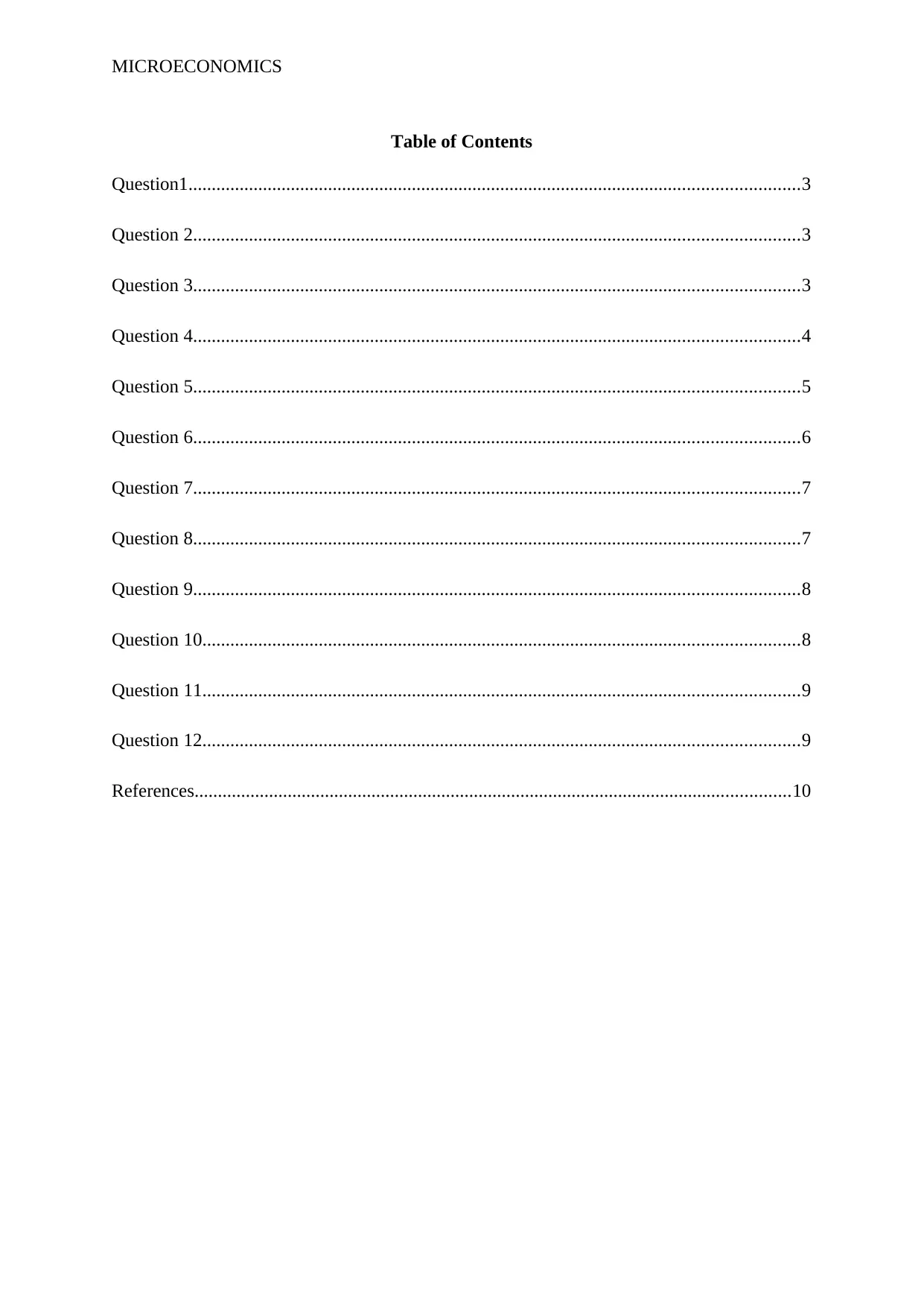
MICROECONOMICS
Table of Contents
Question1...................................................................................................................................3
Question 2..................................................................................................................................3
Question 3..................................................................................................................................3
Question 4..................................................................................................................................4
Question 5..................................................................................................................................5
Question 6..................................................................................................................................6
Question 7..................................................................................................................................7
Question 8..................................................................................................................................7
Question 9..................................................................................................................................8
Question 10................................................................................................................................8
Question 11................................................................................................................................9
Question 12................................................................................................................................9
References................................................................................................................................10
Table of Contents
Question1...................................................................................................................................3
Question 2..................................................................................................................................3
Question 3..................................................................................................................................3
Question 4..................................................................................................................................4
Question 5..................................................................................................................................5
Question 6..................................................................................................................................6
Question 7..................................................................................................................................7
Question 8..................................................................................................................................7
Question 9..................................................................................................................................8
Question 10................................................................................................................................8
Question 11................................................................................................................................9
Question 12................................................................................................................................9
References................................................................................................................................10
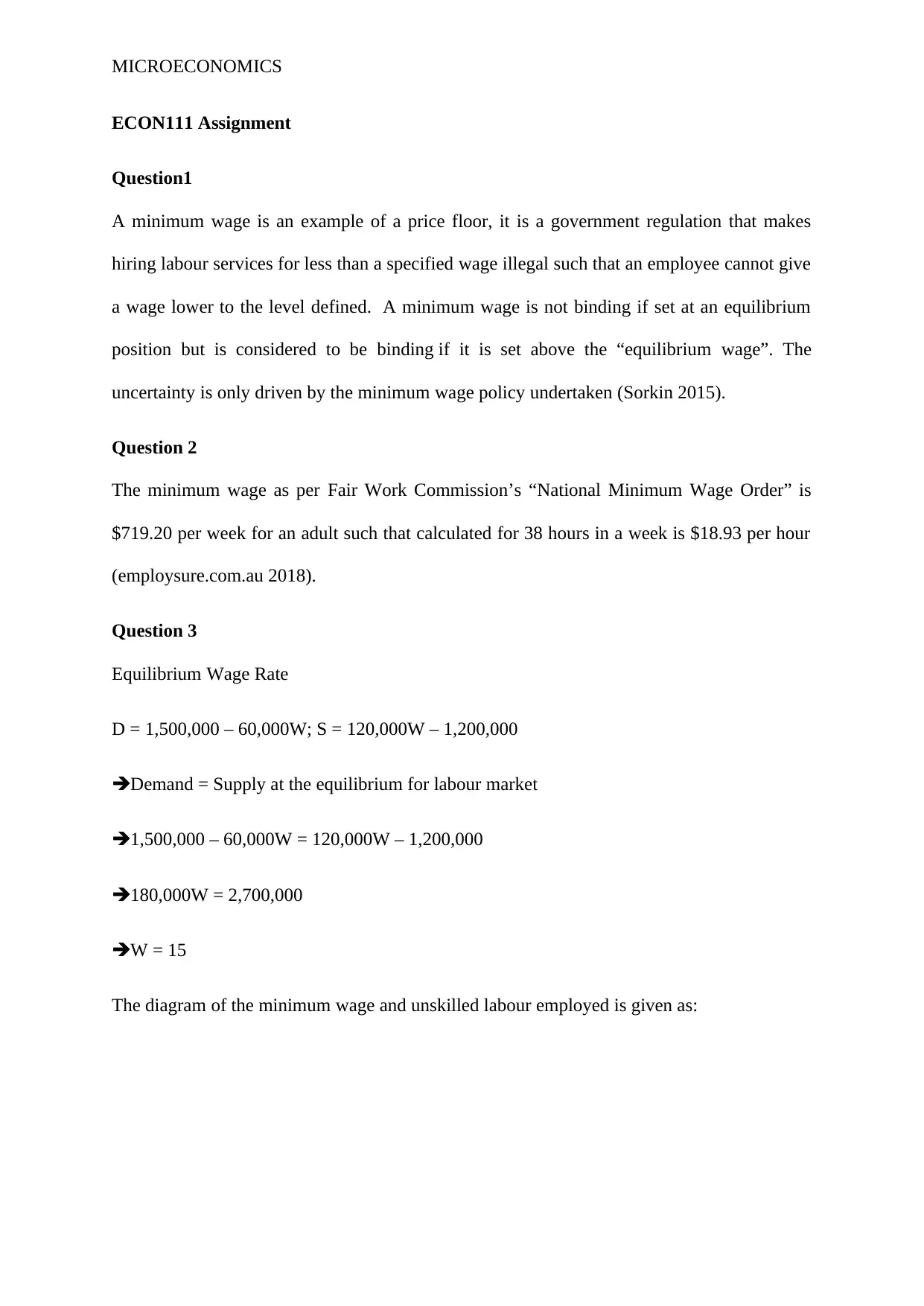
MICROECONOMICS
ECON111 Assignment
Question1
A minimum wage is an example of a price floor, it is a government regulation that makes
hiring labour services for less than a specified wage illegal such that an employee cannot give
a wage lower to the level defined. A minimum wage is not binding if set at an equilibrium
position but is considered to be binding if it is set above the “equilibrium wage”. The
uncertainty is only driven by the minimum wage policy undertaken (Sorkin 2015).
Question 2
The minimum wage as per Fair Work Commission’s “National Minimum Wage Order” is
$719.20 per week for an adult such that calculated for 38 hours in a week is $18.93 per hour
(employsure.com.au 2018).
Question 3
Equilibrium Wage Rate
D = 1,500,000 – 60,000W; S = 120,000W – 1,200,000
Demand = Supply at the equilibrium for labour market
1,500,000 – 60,000W = 120,000W – 1,200,000
180,000W = 2,700,000
W = 15
The diagram of the minimum wage and unskilled labour employed is given as:
ECON111 Assignment
Question1
A minimum wage is an example of a price floor, it is a government regulation that makes
hiring labour services for less than a specified wage illegal such that an employee cannot give
a wage lower to the level defined. A minimum wage is not binding if set at an equilibrium
position but is considered to be binding if it is set above the “equilibrium wage”. The
uncertainty is only driven by the minimum wage policy undertaken (Sorkin 2015).
Question 2
The minimum wage as per Fair Work Commission’s “National Minimum Wage Order” is
$719.20 per week for an adult such that calculated for 38 hours in a week is $18.93 per hour
(employsure.com.au 2018).
Question 3
Equilibrium Wage Rate
D = 1,500,000 – 60,000W; S = 120,000W – 1,200,000
Demand = Supply at the equilibrium for labour market
1,500,000 – 60,000W = 120,000W – 1,200,000
180,000W = 2,700,000
W = 15
The diagram of the minimum wage and unskilled labour employed is given as:
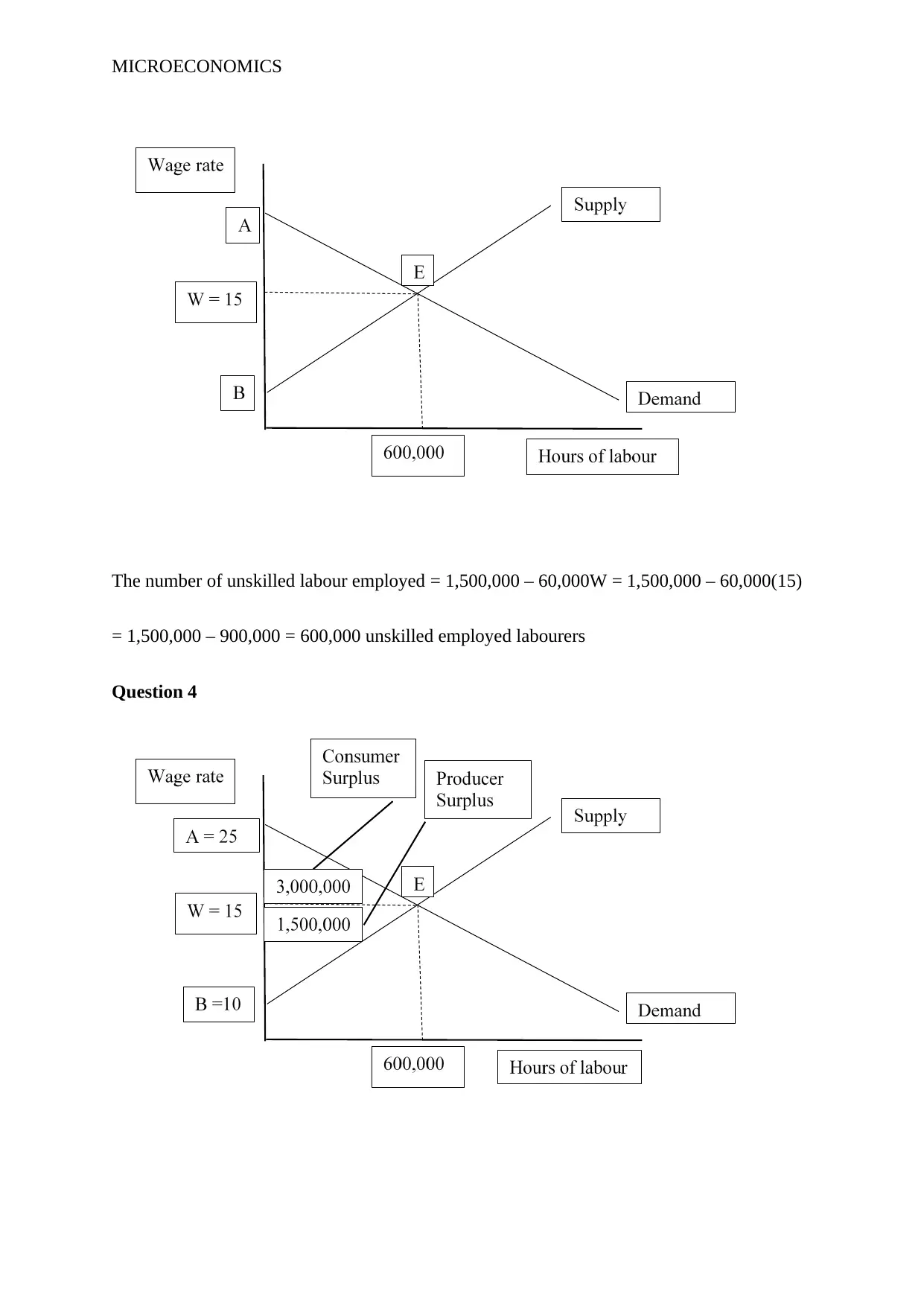
MICROECONOMICS
The number of unskilled labour employed = 1,500,000 – 60,000W = 1,500,000 – 60,000(15)
= 1,500,000 – 900,000 = 600,000 unskilled employed labourers
Question 4
The number of unskilled labour employed = 1,500,000 – 60,000W = 1,500,000 – 60,000(15)
= 1,500,000 – 900,000 = 600,000 unskilled employed labourers
Question 4
Secure Best Marks with AI Grader
Need help grading? Try our AI Grader for instant feedback on your assignments.
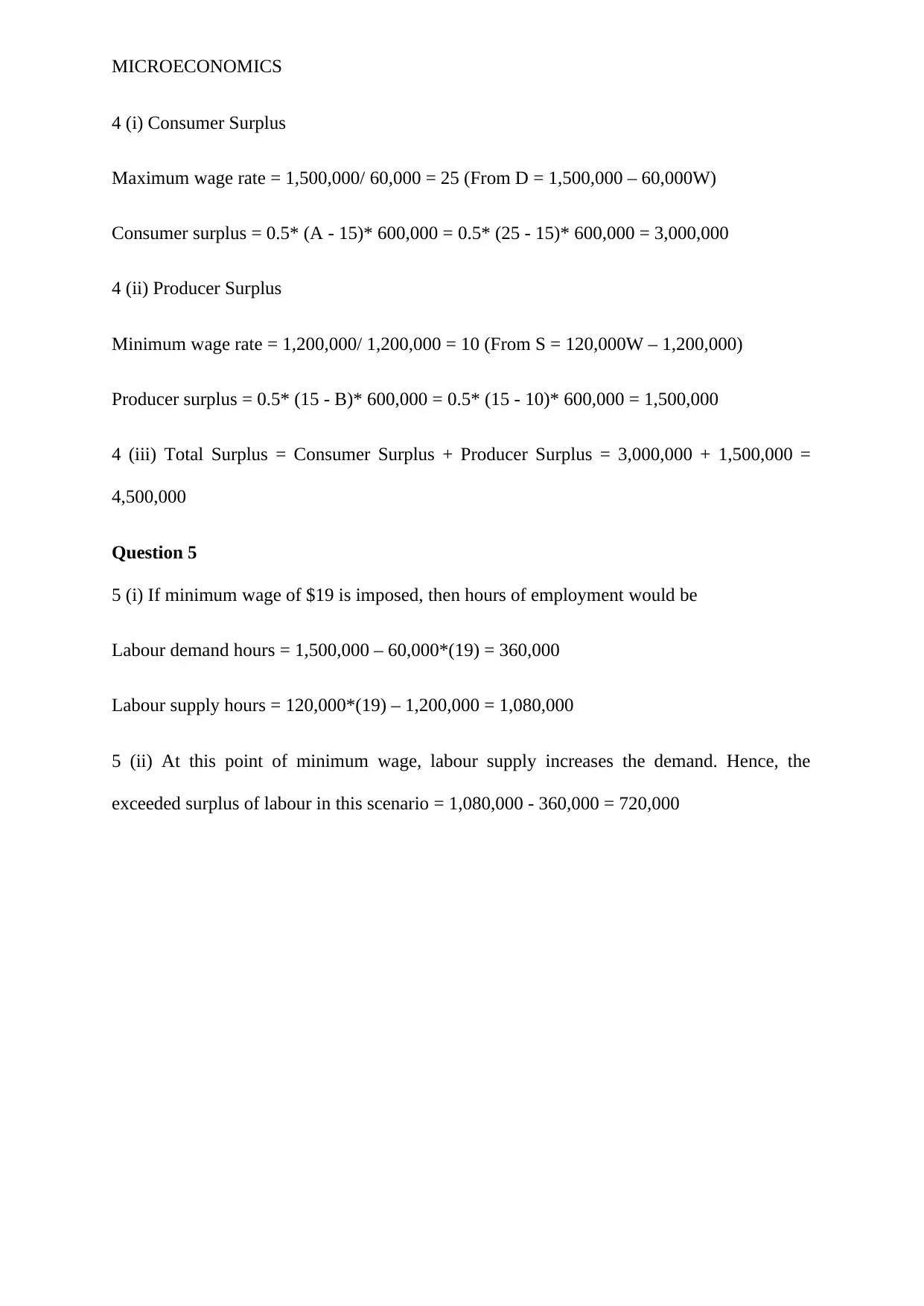
MICROECONOMICS
4 (i) Consumer Surplus
Maximum wage rate = 1,500,000/ 60,000 = 25 (From D = 1,500,000 – 60,000W)
Consumer surplus = 0.5* (A - 15)* 600,000 = 0.5* (25 - 15)* 600,000 = 3,000,000
4 (ii) Producer Surplus
Minimum wage rate = 1,200,000/ 1,200,000 = 10 (From S = 120,000W – 1,200,000)
Producer surplus = 0.5* (15 - B)* 600,000 = 0.5* (15 - 10)* 600,000 = 1,500,000
4 (iii) Total Surplus = Consumer Surplus + Producer Surplus = 3,000,000 + 1,500,000 =
4,500,000
Question 5
5 (i) If minimum wage of $19 is imposed, then hours of employment would be
Labour demand hours = 1,500,000 – 60,000*(19) = 360,000
Labour supply hours = 120,000*(19) – 1,200,000 = 1,080,000
5 (ii) At this point of minimum wage, labour supply increases the demand. Hence, the
exceeded surplus of labour in this scenario = 1,080,000 - 360,000 = 720,000
4 (i) Consumer Surplus
Maximum wage rate = 1,500,000/ 60,000 = 25 (From D = 1,500,000 – 60,000W)
Consumer surplus = 0.5* (A - 15)* 600,000 = 0.5* (25 - 15)* 600,000 = 3,000,000
4 (ii) Producer Surplus
Minimum wage rate = 1,200,000/ 1,200,000 = 10 (From S = 120,000W – 1,200,000)
Producer surplus = 0.5* (15 - B)* 600,000 = 0.5* (15 - 10)* 600,000 = 1,500,000
4 (iii) Total Surplus = Consumer Surplus + Producer Surplus = 3,000,000 + 1,500,000 =
4,500,000
Question 5
5 (i) If minimum wage of $19 is imposed, then hours of employment would be
Labour demand hours = 1,500,000 – 60,000*(19) = 360,000
Labour supply hours = 120,000*(19) – 1,200,000 = 1,080,000
5 (ii) At this point of minimum wage, labour supply increases the demand. Hence, the
exceeded surplus of labour in this scenario = 1,080,000 - 360,000 = 720,000
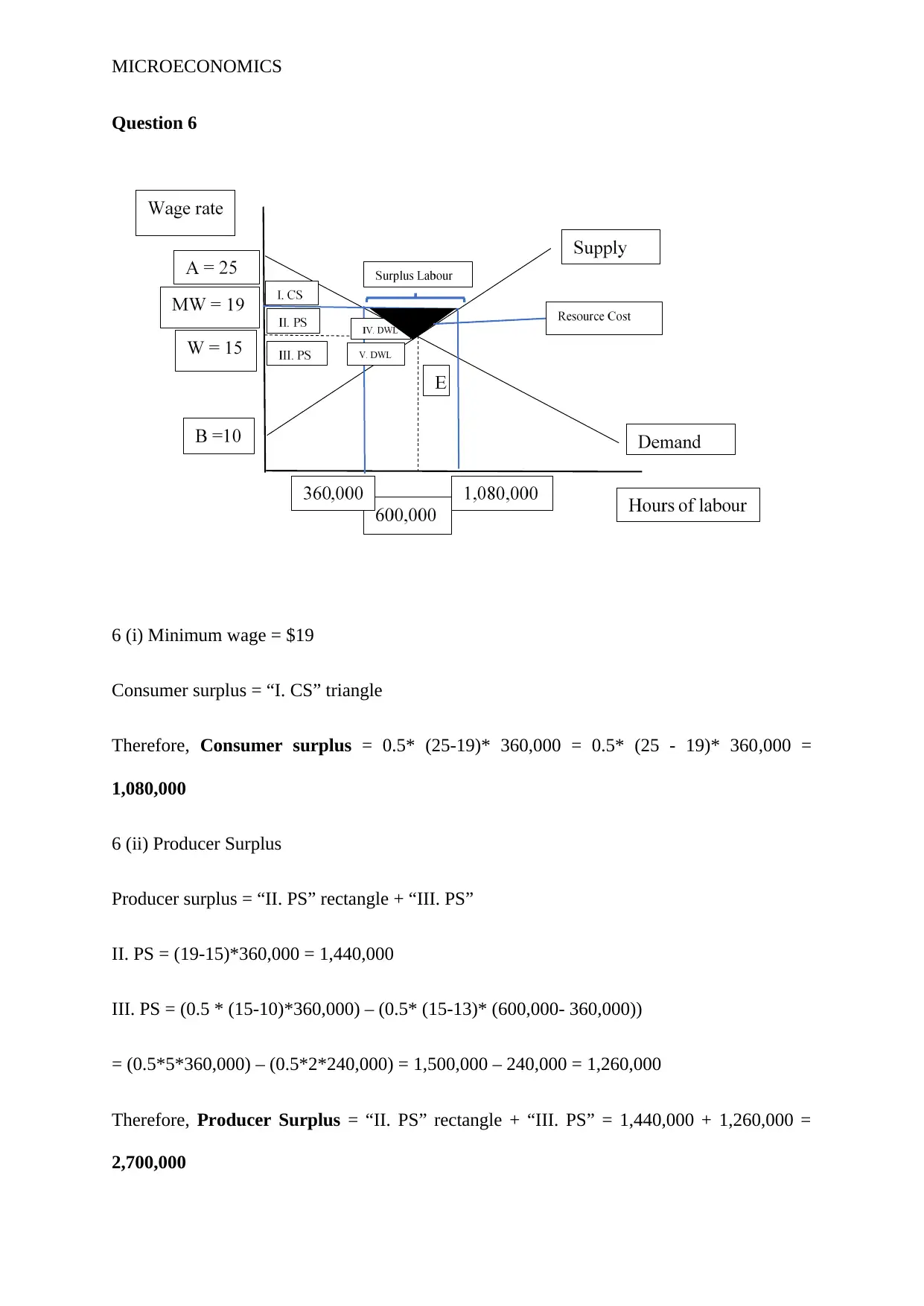
MICROECONOMICS
Question 6
6 (i) Minimum wage = $19
Consumer surplus = “I. CS” triangle
Therefore, Consumer surplus = 0.5* (25-19)* 360,000 = 0.5* (25 - 19)* 360,000 =
1,080,000
6 (ii) Producer Surplus
Producer surplus = “II. PS” rectangle + “III. PS”
II. PS = (19-15)*360,000 = 1,440,000
III. PS = (0.5 * (15-10)*360,000) – (0.5* (15-13)* (600,000- 360,000))
= (0.5*5*360,000) – (0.5*2*240,000) = 1,500,000 – 240,000 = 1,260,000
Therefore, Producer Surplus = “II. PS” rectangle + “III. PS” = 1,440,000 + 1,260,000 =
2,700,000
Question 6
6 (i) Minimum wage = $19
Consumer surplus = “I. CS” triangle
Therefore, Consumer surplus = 0.5* (25-19)* 360,000 = 0.5* (25 - 19)* 360,000 =
1,080,000
6 (ii) Producer Surplus
Producer surplus = “II. PS” rectangle + “III. PS”
II. PS = (19-15)*360,000 = 1,440,000
III. PS = (0.5 * (15-10)*360,000) – (0.5* (15-13)* (600,000- 360,000))
= (0.5*5*360,000) – (0.5*2*240,000) = 1,500,000 – 240,000 = 1,260,000
Therefore, Producer Surplus = “II. PS” rectangle + “III. PS” = 1,440,000 + 1,260,000 =
2,700,000
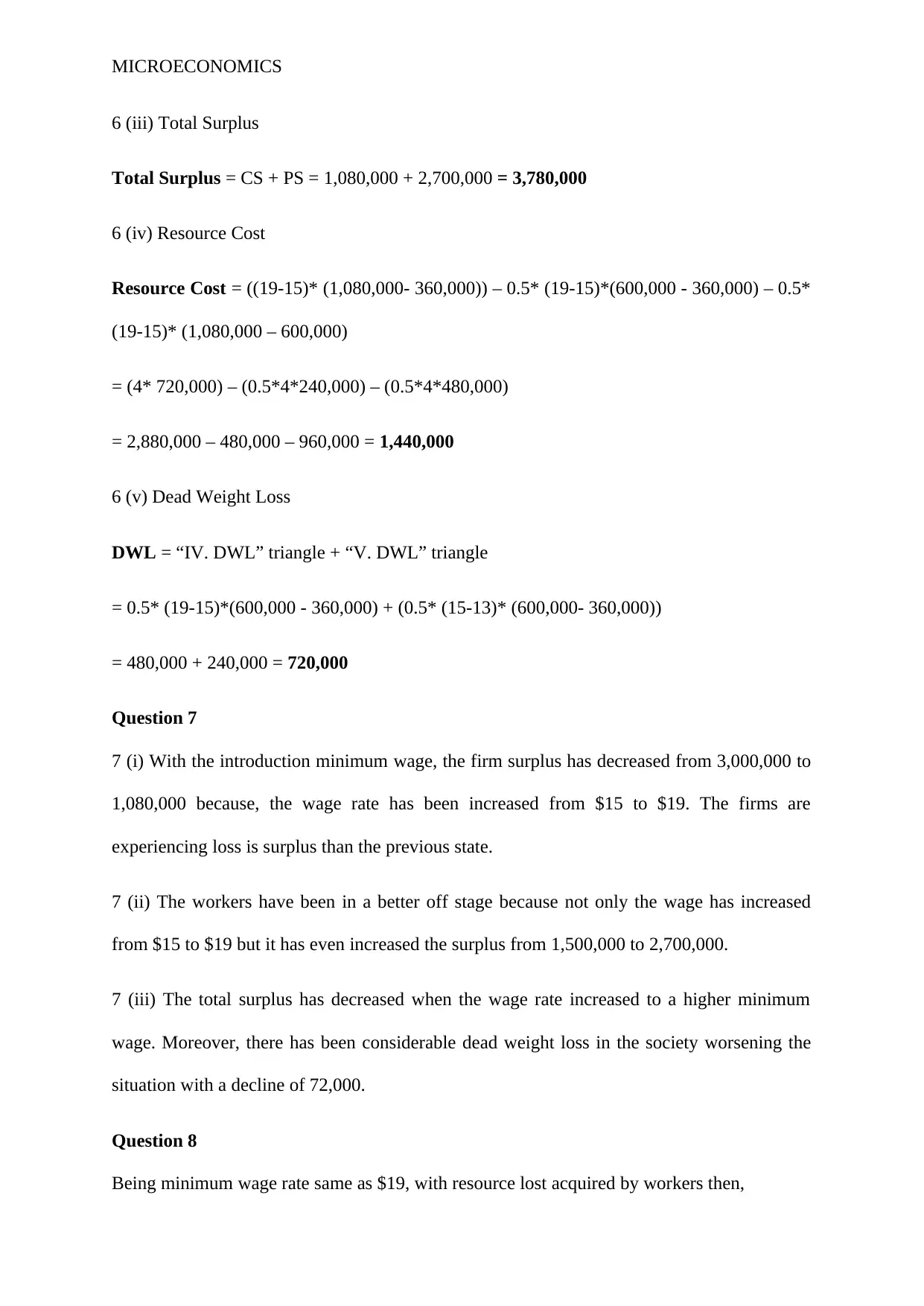
MICROECONOMICS
6 (iii) Total Surplus
Total Surplus = CS + PS = 1,080,000 + 2,700,000 = 3,780,000
6 (iv) Resource Cost
Resource Cost = ((19-15)* (1,080,000- 360,000)) – 0.5* (19-15)*(600,000 - 360,000) – 0.5*
(19-15)* (1,080,000 – 600,000)
= (4* 720,000) – (0.5*4*240,000) – (0.5*4*480,000)
= 2,880,000 – 480,000 – 960,000 = 1,440,000
6 (v) Dead Weight Loss
DWL = “IV. DWL” triangle + “V. DWL” triangle
= 0.5* (19-15)*(600,000 - 360,000) + (0.5* (15-13)* (600,000- 360,000))
= 480,000 + 240,000 = 720,000
Question 7
7 (i) With the introduction minimum wage, the firm surplus has decreased from 3,000,000 to
1,080,000 because, the wage rate has been increased from $15 to $19. The firms are
experiencing loss is surplus than the previous state.
7 (ii) The workers have been in a better off stage because not only the wage has increased
from $15 to $19 but it has even increased the surplus from 1,500,000 to 2,700,000.
7 (iii) The total surplus has decreased when the wage rate increased to a higher minimum
wage. Moreover, there has been considerable dead weight loss in the society worsening the
situation with a decline of 72,000.
Question 8
Being minimum wage rate same as $19, with resource lost acquired by workers then,
6 (iii) Total Surplus
Total Surplus = CS + PS = 1,080,000 + 2,700,000 = 3,780,000
6 (iv) Resource Cost
Resource Cost = ((19-15)* (1,080,000- 360,000)) – 0.5* (19-15)*(600,000 - 360,000) – 0.5*
(19-15)* (1,080,000 – 600,000)
= (4* 720,000) – (0.5*4*240,000) – (0.5*4*480,000)
= 2,880,000 – 480,000 – 960,000 = 1,440,000
6 (v) Dead Weight Loss
DWL = “IV. DWL” triangle + “V. DWL” triangle
= 0.5* (19-15)*(600,000 - 360,000) + (0.5* (15-13)* (600,000- 360,000))
= 480,000 + 240,000 = 720,000
Question 7
7 (i) With the introduction minimum wage, the firm surplus has decreased from 3,000,000 to
1,080,000 because, the wage rate has been increased from $15 to $19. The firms are
experiencing loss is surplus than the previous state.
7 (ii) The workers have been in a better off stage because not only the wage has increased
from $15 to $19 but it has even increased the surplus from 1,500,000 to 2,700,000.
7 (iii) The total surplus has decreased when the wage rate increased to a higher minimum
wage. Moreover, there has been considerable dead weight loss in the society worsening the
situation with a decline of 72,000.
Question 8
Being minimum wage rate same as $19, with resource lost acquired by workers then,
Paraphrase This Document
Need a fresh take? Get an instant paraphrase of this document with our AI Paraphraser
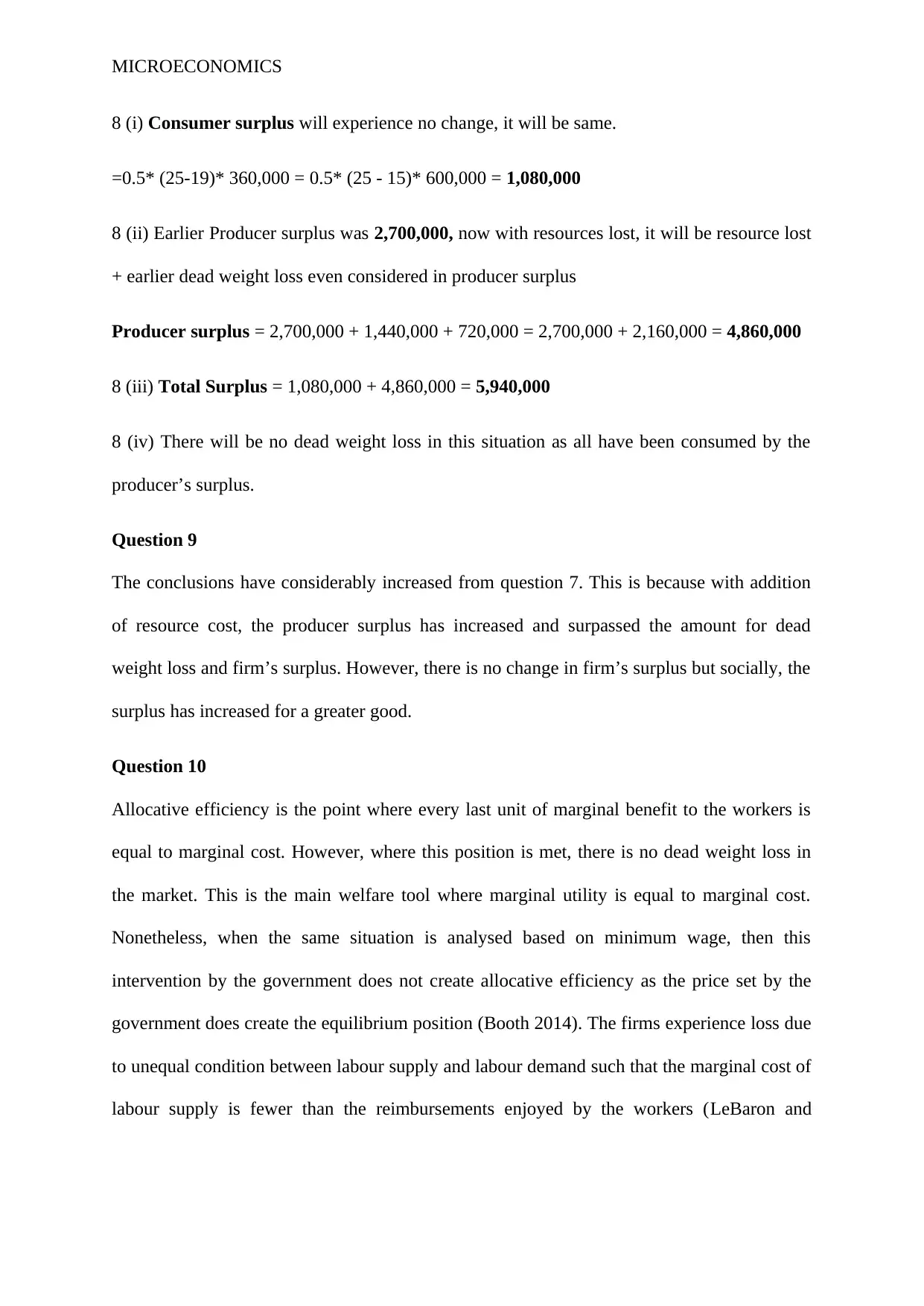
MICROECONOMICS
8 (i) Consumer surplus will experience no change, it will be same.
=0.5* (25-19)* 360,000 = 0.5* (25 - 15)* 600,000 = 1,080,000
8 (ii) Earlier Producer surplus was 2,700,000, now with resources lost, it will be resource lost
+ earlier dead weight loss even considered in producer surplus
Producer surplus = 2,700,000 + 1,440,000 + 720,000 = 2,700,000 + 2,160,000 = 4,860,000
8 (iii) Total Surplus = 1,080,000 + 4,860,000 = 5,940,000
8 (iv) There will be no dead weight loss in this situation as all have been consumed by the
producer’s surplus.
Question 9
The conclusions have considerably increased from question 7. This is because with addition
of resource cost, the producer surplus has increased and surpassed the amount for dead
weight loss and firm’s surplus. However, there is no change in firm’s surplus but socially, the
surplus has increased for a greater good.
Question 10
Allocative efficiency is the point where every last unit of marginal benefit to the workers is
equal to marginal cost. However, where this position is met, there is no dead weight loss in
the market. This is the main welfare tool where marginal utility is equal to marginal cost.
Nonetheless, when the same situation is analysed based on minimum wage, then this
intervention by the government does not create allocative efficiency as the price set by the
government does create the equilibrium position (Booth 2014). The firms experience loss due
to unequal condition between labour supply and labour demand such that the marginal cost of
labour supply is fewer than the reimbursements enjoyed by the workers (LeBaron and
8 (i) Consumer surplus will experience no change, it will be same.
=0.5* (25-19)* 360,000 = 0.5* (25 - 15)* 600,000 = 1,080,000
8 (ii) Earlier Producer surplus was 2,700,000, now with resources lost, it will be resource lost
+ earlier dead weight loss even considered in producer surplus
Producer surplus = 2,700,000 + 1,440,000 + 720,000 = 2,700,000 + 2,160,000 = 4,860,000
8 (iii) Total Surplus = 1,080,000 + 4,860,000 = 5,940,000
8 (iv) There will be no dead weight loss in this situation as all have been consumed by the
producer’s surplus.
Question 9
The conclusions have considerably increased from question 7. This is because with addition
of resource cost, the producer surplus has increased and surpassed the amount for dead
weight loss and firm’s surplus. However, there is no change in firm’s surplus but socially, the
surplus has increased for a greater good.
Question 10
Allocative efficiency is the point where every last unit of marginal benefit to the workers is
equal to marginal cost. However, where this position is met, there is no dead weight loss in
the market. This is the main welfare tool where marginal utility is equal to marginal cost.
Nonetheless, when the same situation is analysed based on minimum wage, then this
intervention by the government does not create allocative efficiency as the price set by the
government does create the equilibrium position (Booth 2014). The firms experience loss due
to unequal condition between labour supply and labour demand such that the marginal cost of
labour supply is fewer than the reimbursements enjoyed by the workers (LeBaron and
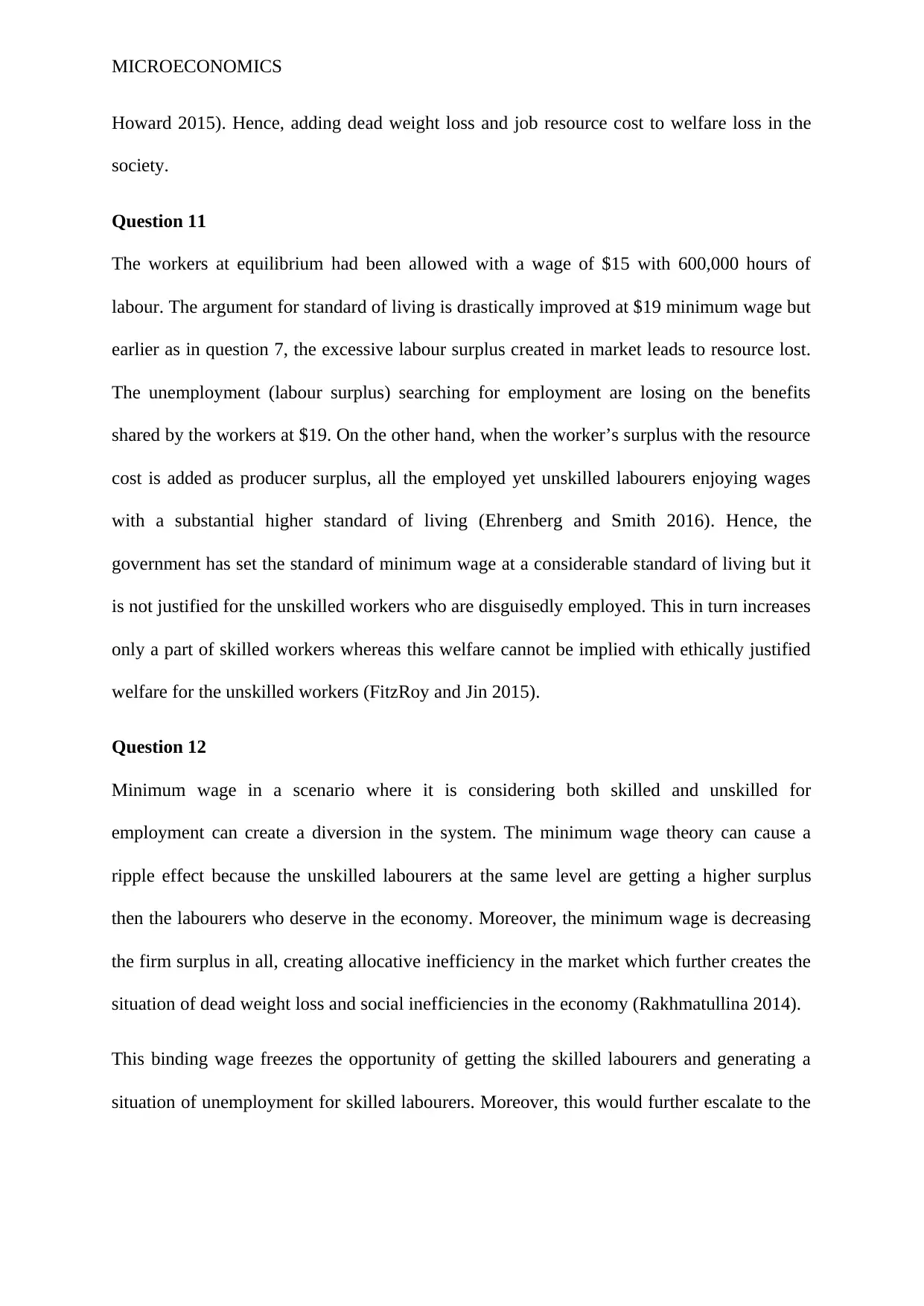
MICROECONOMICS
Howard 2015). Hence, adding dead weight loss and job resource cost to welfare loss in the
society.
Question 11
The workers at equilibrium had been allowed with a wage of $15 with 600,000 hours of
labour. The argument for standard of living is drastically improved at $19 minimum wage but
earlier as in question 7, the excessive labour surplus created in market leads to resource lost.
The unemployment (labour surplus) searching for employment are losing on the benefits
shared by the workers at $19. On the other hand, when the worker’s surplus with the resource
cost is added as producer surplus, all the employed yet unskilled labourers enjoying wages
with a substantial higher standard of living (Ehrenberg and Smith 2016). Hence, the
government has set the standard of minimum wage at a considerable standard of living but it
is not justified for the unskilled workers who are disguisedly employed. This in turn increases
only a part of skilled workers whereas this welfare cannot be implied with ethically justified
welfare for the unskilled workers (FitzRoy and Jin 2015).
Question 12
Minimum wage in a scenario where it is considering both skilled and unskilled for
employment can create a diversion in the system. The minimum wage theory can cause a
ripple effect because the unskilled labourers at the same level are getting a higher surplus
then the labourers who deserve in the economy. Moreover, the minimum wage is decreasing
the firm surplus in all, creating allocative inefficiency in the market which further creates the
situation of dead weight loss and social inefficiencies in the economy (Rakhmatullina 2014).
This binding wage freezes the opportunity of getting the skilled labourers and generating a
situation of unemployment for skilled labourers. Moreover, this would further escalate to the
Howard 2015). Hence, adding dead weight loss and job resource cost to welfare loss in the
society.
Question 11
The workers at equilibrium had been allowed with a wage of $15 with 600,000 hours of
labour. The argument for standard of living is drastically improved at $19 minimum wage but
earlier as in question 7, the excessive labour surplus created in market leads to resource lost.
The unemployment (labour surplus) searching for employment are losing on the benefits
shared by the workers at $19. On the other hand, when the worker’s surplus with the resource
cost is added as producer surplus, all the employed yet unskilled labourers enjoying wages
with a substantial higher standard of living (Ehrenberg and Smith 2016). Hence, the
government has set the standard of minimum wage at a considerable standard of living but it
is not justified for the unskilled workers who are disguisedly employed. This in turn increases
only a part of skilled workers whereas this welfare cannot be implied with ethically justified
welfare for the unskilled workers (FitzRoy and Jin 2015).
Question 12
Minimum wage in a scenario where it is considering both skilled and unskilled for
employment can create a diversion in the system. The minimum wage theory can cause a
ripple effect because the unskilled labourers at the same level are getting a higher surplus
then the labourers who deserve in the economy. Moreover, the minimum wage is decreasing
the firm surplus in all, creating allocative inefficiency in the market which further creates the
situation of dead weight loss and social inefficiencies in the economy (Rakhmatullina 2014).
This binding wage freezes the opportunity of getting the skilled labourers and generating a
situation of unemployment for skilled labourers. Moreover, this would further escalate to the
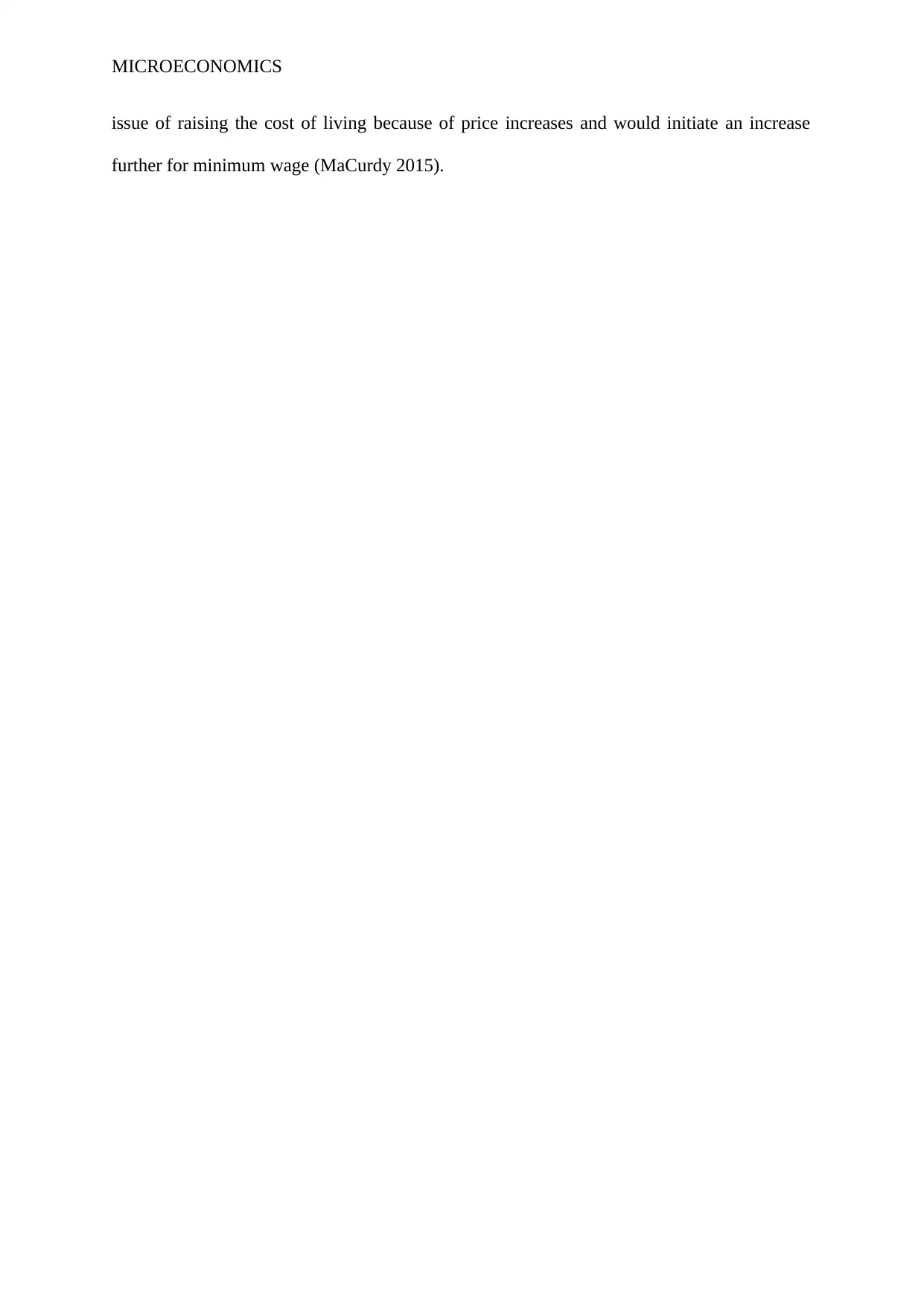
MICROECONOMICS
issue of raising the cost of living because of price increases and would initiate an increase
further for minimum wage (MaCurdy 2015).
issue of raising the cost of living because of price increases and would initiate an increase
further for minimum wage (MaCurdy 2015).
Secure Best Marks with AI Grader
Need help grading? Try our AI Grader for instant feedback on your assignments.
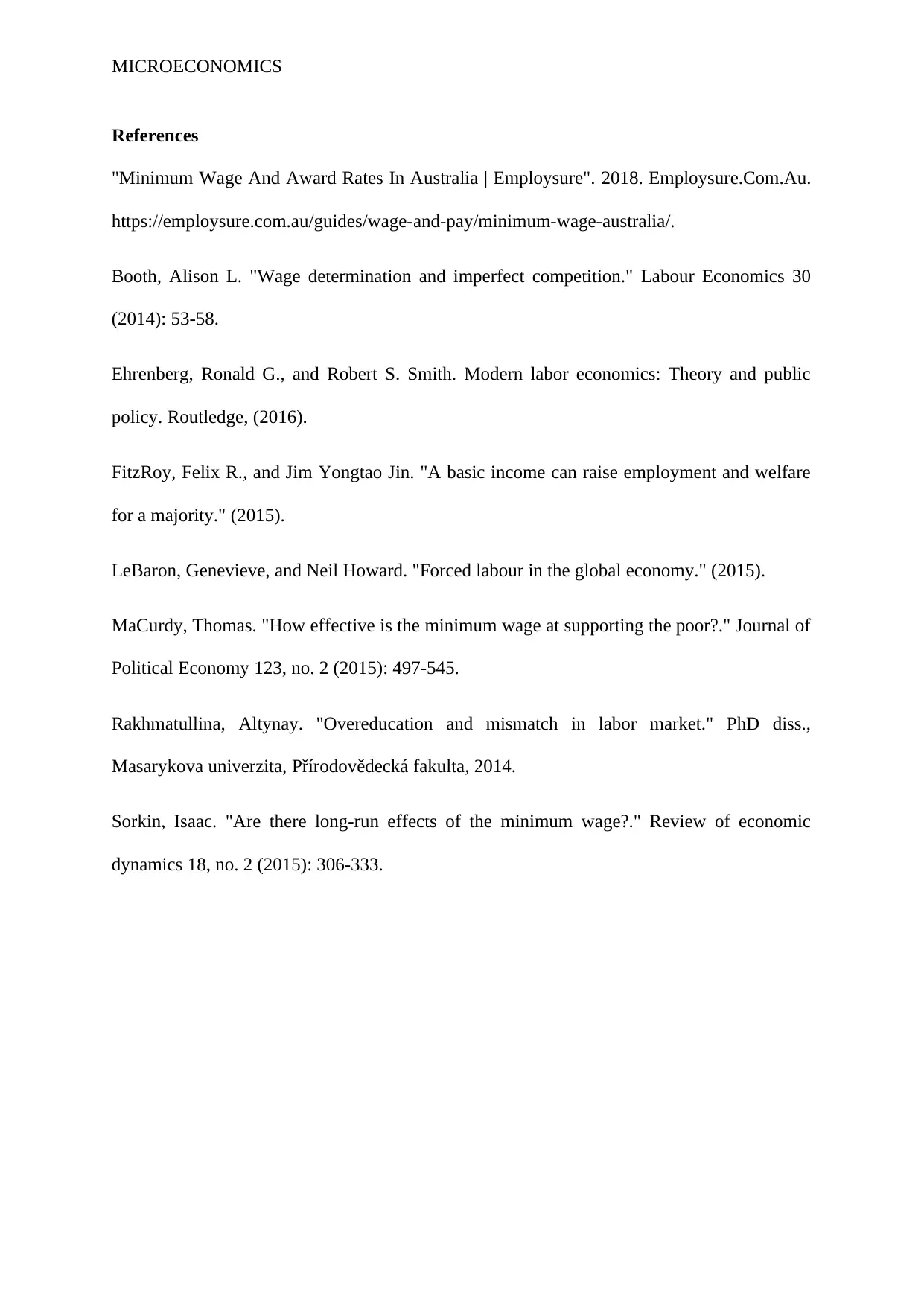
MICROECONOMICS
References
"Minimum Wage And Award Rates In Australia | Employsure". 2018. Employsure.Com.Au.
https://employsure.com.au/guides/wage-and-pay/minimum-wage-australia/.
Booth, Alison L. "Wage determination and imperfect competition." Labour Economics 30
(2014): 53-58.
Ehrenberg, Ronald G., and Robert S. Smith. Modern labor economics: Theory and public
policy. Routledge, (2016).
FitzRoy, Felix R., and Jim Yongtao Jin. "A basic income can raise employment and welfare
for a majority." (2015).
LeBaron, Genevieve, and Neil Howard. "Forced labour in the global economy." (2015).
MaCurdy, Thomas. "How effective is the minimum wage at supporting the poor?." Journal of
Political Economy 123, no. 2 (2015): 497-545.
Rakhmatullina, Altynay. "Overeducation and mismatch in labor market." PhD diss.,
Masarykova univerzita, Přírodovědecká fakulta, 2014.
Sorkin, Isaac. "Are there long-run effects of the minimum wage?." Review of economic
dynamics 18, no. 2 (2015): 306-333.
References
"Minimum Wage And Award Rates In Australia | Employsure". 2018. Employsure.Com.Au.
https://employsure.com.au/guides/wage-and-pay/minimum-wage-australia/.
Booth, Alison L. "Wage determination and imperfect competition." Labour Economics 30
(2014): 53-58.
Ehrenberg, Ronald G., and Robert S. Smith. Modern labor economics: Theory and public
policy. Routledge, (2016).
FitzRoy, Felix R., and Jim Yongtao Jin. "A basic income can raise employment and welfare
for a majority." (2015).
LeBaron, Genevieve, and Neil Howard. "Forced labour in the global economy." (2015).
MaCurdy, Thomas. "How effective is the minimum wage at supporting the poor?." Journal of
Political Economy 123, no. 2 (2015): 497-545.
Rakhmatullina, Altynay. "Overeducation and mismatch in labor market." PhD diss.,
Masarykova univerzita, Přírodovědecká fakulta, 2014.
Sorkin, Isaac. "Are there long-run effects of the minimum wage?." Review of economic
dynamics 18, no. 2 (2015): 306-333.
1 out of 11
Related Documents
Your All-in-One AI-Powered Toolkit for Academic Success.
+13062052269
info@desklib.com
Available 24*7 on WhatsApp / Email
![[object Object]](/_next/static/media/star-bottom.7253800d.svg)
Unlock your academic potential
© 2024 | Zucol Services PVT LTD | All rights reserved.



